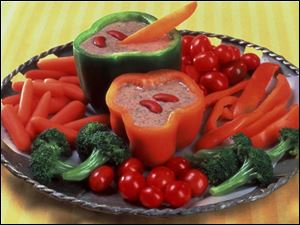
New guidelines for organic labeling
10/26/2002There's been a lot of buzz about the unveiling of the USDA's National Organic Standards guidelines last Monday.
Through the last decade unofficial standards as to what could be advertised or labeled as organic for foods slowly, but surely, were tightened.
Well now it's official. “Oct. 21 was the beginning of the program,” says Joan Schaffer, USDA public affairs specialist in Washington. Food already on the shelf that is labeled organic without the seal can stay there. “We're not asking anyone to destroy food on the shelves.”
In fact, organic farmers and handlers have 18 months to adjust their growing and processing operations and revise their product labels to conform to the standards.
Yet it's difficult to imagine that these are the first national standards for foods produced organically. Previously, different states and organic organizations had varying standards. Now all farmers, food producers, and consumers agree upon what organic means.

The U.S. Department of Agriculture has new rules for labeling foods `organic.'
Foods that are produced organically don't have synthetic pesticides, fertilizers, hormones, or genetically modified ingredients.
The USDA Organic Seal may be used on products that are 100 percent organic or 95 to 99 percent organic.
When a food is labeled “100 per cent organic,” the product must contain only organically produced raw or processed material, excluding water and salt.
“Organic” products must be at least 95 percent organically produced ingredients. The label must state the percentage of organic ingredients.
Products that are 70 to 94 percent organic cannot carry the USDA Organic Seal; however the front label can read: “Made with Organic Ingredients” and must contain at least 70 percent organic ingredients. When a product displays the term “made with organic ingredients” it can list up to three of the product's organic ingredients or food groups.
Organic products that are less than 70 percent organic cannot carry the USDA Organic Seal, nor can the word “organic” be displayed anywhere on the front label. Organic ingredients can be identified.
“Organic” is an agricultural production claim that identifies food grown with farming practices that improve the soil, protect water quality, and avoid use of toxic synthetic pesticides, herbicides, fungicides, insecticides, and genetic engineering, according to information from Cascadian Farm, makers of organic food products.
Organic products have become easier to find on the shelf or in the produce department of supermarkets. Shelf space has been expanding because of consumer demand. According to the Organic Trade Association, sales are expected to reach $20 billion by 2005.
For example, orders for frozen organic turkeys are now being accepted at stores such as Phoenix Food Co-op, reports Helen Elden, market manager. Supplied by Organic Valley, these turkeys are raised without antibiotics and on feed grown without pesticides.
Fresh free-range turkeys for Thanksgiving may also be ordered for pick-up. These have not been given any hormones or antibiotics, but their feed was not organic, says Ms. Elden.
Other area stores taking orders and selling organic turkeys include Claudia's Natural Food Market.
Chefs Collaborative members believe that the source of their ingredients - the way they have been grown, raised, or caught - affects the flavor and quality of their food.
“Many members do believe knowing where your food comes from makes you a better consumer,” says Nancy Civetta of Chefs Collaborative. “They embrace the concept of organics because there's a traceability back to the farm.”
The group emphasizes cooking what is locally grown and in season. “However, they would choose locally grown first rather than shipping organic product from across the country,” she says. “However, they embrace the organic standards.”
She notes that the best known all-organic restaurant are Nora Pouillon's restaurants (Asia Nora and Restaurant Nora) in Washington. “Everybody else [provides as much organics] as they can,” says Ms. Civetta about the list of restaurants that provide sustainably produced food.
To get the Chefs Collaborative guide, call 617-236-5200 or visit www.stonyfield.com. The guide is free while supplies last.